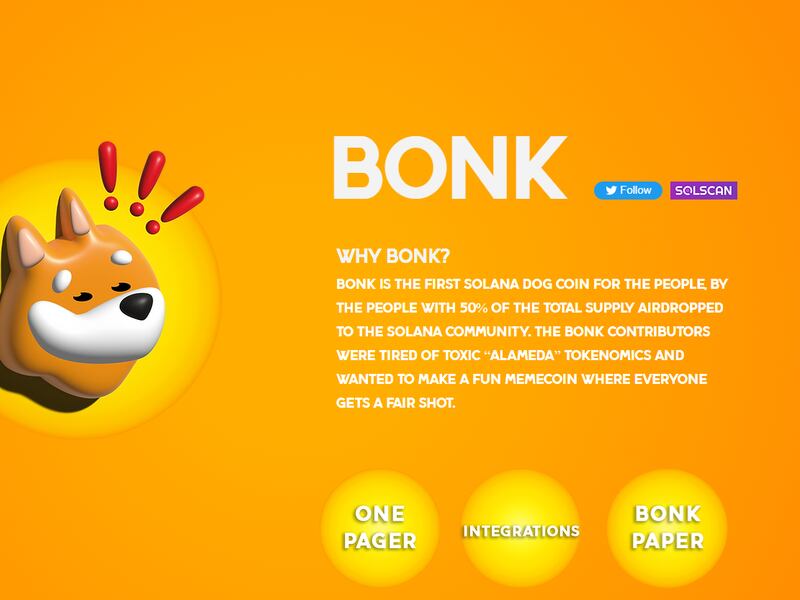Inside Bonk Inu: How 22 Developers Put the Shiba Inu Fun Into Solana and Away From FTX

In the past few weeks, a Shiba Inu-themed token took center stage in the Solana ecosystem as sentiment around the blockchain network took a hit in the aftermath of the Sam Bankman-Fried and FTX debacle.
Called Bonk Inu (BONK), the project with a cute dog holding a bat as a mascot launched with just a homepage and a “bonkpaper” in the final weeks of 2022.

But the lack of clear team information or even a dedicated community channel didn’t deter entrants from punting their hopes: BONK ran up as much as 3,200% in just three weeks, almost single-handedly inciting activity in the Solana ecosystem, as previously reported.
Bonk Inu became the talk of Crypto Twitter town almost overnight with almost everyone wondering the same thing, “What is Bonk anyway?”
Bonk Inu is a team of twenty-two individuals, with no singular leader, all of whom were involved in the inception of the project, CoinDesk learned from one of the several developers. All of them have previously built decentralized applications (DeFi), non-fungible tokens (NFTs) and other related products on Solana.
“There is no core team. It’s all volunteers,” said KW, a pseudonymous Bonk Inu team member, during a chat with CoinDesk. “We’ve all been in the Solana ecosystem for a long time and built relationships over the last two years.”
The Bonk airdrop – amounting to 50% of its token supply – likely drove massive community interest and instant hype. Some 20% of the total airdrop supply is going to Solana NFT collections – comprising 297,000 individual NFTs – and 10% to Solana-focused artists and collectors. Airdrops refer to an unsolicited distribution of a cryptocurrency token or coin, usually for free, to numerous wallet addresses and are generally used as a tactic to gain users.
See also: Shiba Inu-Themed BONK Tokens Are Yielding Nearly 1,000% for Solana Liquidity Providers
But why Bonk Inu?
For background: Bankman-Fried had been among the most vocal supporters of Solana since early 2020, launching the decentralized exchange Serum on the network, publicly offering to buy all SOL he could get his hands on at $3, and investing hundreds of millions in the network through funds such as Sino Global Capital.
The charade lasted all of two years.
Distraught, disgusted, and jaded. That was the prevailing sentiment on Crypto Twitter when reports of possible fraud at SBF’s then-behemoth crypto exchange FTX first broke out in November last year.
Once the darling of the crypto space, the main players running Bankman-Fried’s FTX were found guilty of concocting an elaborate scheme that commingled billions of dollars in customer deposits to fund trading activities at closely-related Alameda Research, which SBF was a co-founder of.
FTX and Alameda have since been taken over by liquidators. SBF was arrested and taken to court in New York. Alameda CEO Caroline Ellison and Gary Wang, a key FTX engineer, pled guilty. And Solana’s SOL tokens fell to as low as $9 as a known player of the ecosystem went down – contributing to a hit in sentiment.
Read more: Why Solana Was Decimated by Bankman-Fried’s Downfall
The twenty-two Solana developers, however, took no time to distance themselves from Bankman-Fried’s dirt and rebuilt conversation around the decentralized network. They instead banded together to build a “community coin” – and with that, a dog-themed protocol was the way to go.
There’s no rival
The team does not see itself as a dogecoin (DOGE) or shiba inu (SHIB) rival and points out that it's already different from the gazillions of dog-themed memecoins already in the market.
“It's already more useful than either of those. There’s (not) much you can do with shib or doge on chain,” KW stated, adding there are over fifty integrations with other projects for using BONK already.
The integrations include use cases ranging from minting NFTs, to using BONK to trade futures and options, to betting with BONK at Solana-based Casino, and eventually buying a Solana Saga mobile directly with BONK.
$BONK is proud to be the largest sponsor of the Sandstorm Hackathon! https://t.co/8LSOvV54X8 pic.twitter.com/3Ur4aSUNYU
— Bonk! (@bonk_inu) January 12, 2023
As such, the developers have no imminent plans of creating a bespoke blockchain network around Bonk Inu, unlike Shiba Inu’s upcoming Shibarium protocol. For them, it’s all about increasing Solana’s transactional usage and showcasing the benefits of the cheap network.
“There is no reason to make a new blockchain because Solana is fast, cheap, and scales,” KW said. “(We want to) drive attention to all the amazing stuff being built on Solana. Support the Solana ecosystem with the DAO funds.”
Fees on Solana run into fractions of a penny per transaction, compared to a few dollars on Ethereum, which is expensive for widespread usage.
As such, Solana Labs nor the Solana Foundation were involved in Bonk Inu’s creation, the developer said.
The Bonk Inu plan has seemed to work, so far. Research from Delphi Digital earlier this week noted that total active wallets interacting with Solana-based exchanges have increased 83% from almost 45,000 per day to over 83,000 per day.
“The increase in activity comes without any fundamental change or catalyst for the network,” Delphi analysts said in the report, noting the issuance of BONK in late December. However, they did not cite bonk tokens as a key reason behind the Solana resurgence.
BONK prices, meanwhile, have taken a hit as the initial hype has worn down. Prices are down 80% since last week’s peak, CoinGecko data shows, which saw the tokens reach a market capitalization of over $150 million.
But the likes of KW aren’t unlikely to be concerned: “We are super excited this has drawn attention back to what matters on Solana, its incredible infra, and a solid community of users and builders that are going to make more amazing things over time."








